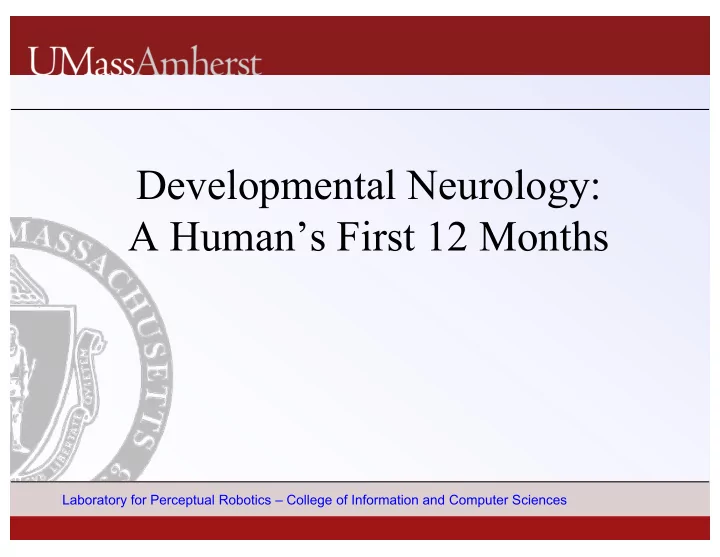

Developmental Neurology: A Human’s First 12 Months Laboratory for Perceptual Robotics – College of Information and Computer Sciences
Brain Development and Physical Maturation Cell birth (neurogenesis) - early brain contains stem cells that replicate and differentiate to form neurons - 1 billion by 5 months, 100 billion by birth Cell migration - movement from neural tube to different parts of the brain, largely completed by birth Neural differentiation - precursor cells differentiate to form specialized neurons, project fibers to neighboring cells (synaptogenesis) Growth and maturation - proliferation of synapses, many more than present in the mature brain, culled after birth Death and synaptic rearrangement - interaction and experience, cell death in the absense of stimulation - use it or loose it Myelination - fatty sheath around neural fibers that alters resistivity and capacitance, changes signal speed (timing) and amplitude. 29 29
Motor Units The CNS is organized in terms of movement patterns---the basic movement pattern is the reflex Descartes � reflex flexor-withdrawl reflex 29 29
Limbic Reflexes - Visceral, Vegetative, and Behavioral laryngeal - cough in response to irritation of the larynx pharyngeal reflex - � gag � sucking/rooting/tongue retrusion - reflexive repertoire for finding, impelling, and expelling objects/food from the mouth, inhibit the gag reflex acoustic stapedius reflex - muscle attached to the stapedius muscle contracts to protect the middle ear from excessive noise eye blink - defensive, stimulated by looming, corneal contact micturation - desire to urinate in response to full bladder anal reflex - sphincter contraction 29 29
Brain Stem Mediated Neonatal/Primitive Reflexes chemical, hormonal, motor, behavioral response to triggering stimuli Moro - emerges 8-9 weeks in utero, inhibited by 16 weeks 3 months newborn after 16 weeks, transforms into the mature � startle � reflex that engages additional perceptual cortical areas 29 29
Brain Stem Mediated Neonatal/Primitive Reflexes Palmar grasp - emerges 11 weeks in utero, inhibited 2-3 months after birth 3 months newborn if it persists too long, it may delay manual dexterity, hand-to-mouth coordination, cause swallowing problems and delayed speech about 36 weeks after birth, transforms into the adult pincer grasp 29 29
Brain Stem Mediated Neonatal/Primitive Reflexes Plantar Reflex - emerges 18 weeks in utero, inhibited 6 months after birth plantar grasp (Babinski) facilitates kicking, muscle tone, provides vestibular stimulation, assists in birthing process, begins process of myelination in CNS for creeping, laterality, hand-eye coordination, and integration of vestibular feedback 29 29
Brain Stem Mediated Neonatal/Primitive Reflexes Asymmetric Tonic Neck Reflex (ATNR) - emerges 18 weeks in utero, inhibited 6 months after birth facilitates movement down birth canal, helps to maintain unobstructed airways, focuses eyes on outstretched hands, extend focal range from about 17 cm to arm’s length. If it persists too long, may delay the ability to focus eyes to longer range targets and over generalize homolateral movements. 29 29
Brain Stem Mediated Neonatal/Primitive Reflexes Galant Reflex - emerges 20 weeks in utero, inhibited by 9 months after birth ipsilateral curving of trunk in response to tactile stimulation on flank, helps learn to rotate, stimulates torso movement useful for crawling, creeping, walking. If it persists too long, induces hip rotation in walking posture and gait, interferes with amphibian and segmental rolling reflexes 29 29
Brain Stem Mediated Neonatal/Primitive Reflexes Galant Reflex - emerges 20 weeks in utero, inhibited by 9 months after birth 3 months 29 29
Brain Stem Mediated Neonatal/Primitive Reflexes Primary Stepping Reflex - spinal reflex, presents at birth, disappears in 3-4 weeks, re-appears at about 12-24 months Labyrinthine Reflex - integrated at the brain stem, head rises off the floor in the prone position---one DOF inverted pendulum 29 29
Postural Reflexes Positive Supporting Reflex - emerges 3-4 months and persists throughout life, tactile stimuli on sole of foot causes a muscle stretch reflex and creates a pillar-like support for the body weight 29 29
Postural Reflexes Righting Reflex - reflexive turning of shoulders and trunk in the direction of the head, presents at birth and is observed until about 4 months, at which time, it is integrated into voluntary movements Optical-Head Righting Reflex - emerges at 2-3 months, remains for life, related to balance and eye movement control, if delayed, can lead to poor visual tracking, motion sickness, and disorientation Labyrinthine-Head Righting Reflex - emerges 2-3 months after birth and remains, vestibular counterpart of OHRR, essential for balance and integrated optical focus 29 29
Postural Reflexes Amphibian Reflex - emerges 4-6 months and remains, essential for crawling, walking, running, persistence indicates a problem inhibiting primitive reflexes Segmental Rolling Reflex - emerges around 6 months and persists, employed in cross-lateral movements - walking, running, jumping, swimming, allows baby to roll over and up into sitting position Lateral Propping Reflex - analog of positive support reflex, weight bearing extension of the arm essential for protective bracing, emerges 5-7 months after birth and persists 29 29
Postural Reflexes Parachute Reflex - emerges 8-9 months after birth, and is retained, vestibular trigger 12 months 6 months Landau Reflex - � superman � pose, legs reflexively drop down into flexion when the infant � s head is pushed down 29 29
Developmental Trajectory …proximo-distal, cephalo-caudal, quasistatic-dynamic 29 29
Infant Sensorimotor Development - the First Year tacit incremental expression of knowledge in a common implicit neurological framework explicit Landscape of Attractors 15 15
Esther Thelen’s – Dynamical Systems Theory 29 29
Recommend
More recommend